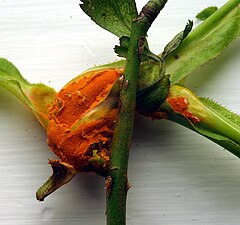Phragmidium
| Phragmidium | |
|---|---|
 |
|
| Scientific classification | |
| Kingdom: | Fungi |
| Division: | Basidiomycota |
| Class: | Pucciniomycetes |
| Order: | Pucciniales |
| Family: | Phragmidiaceae |
| Genus: |
Phragmidium Link (1815) |
| Type species | |
|
Phragmidium mucronatum (Pers.) Schltdl. (1824) |
|
| Synonyms | |
|
Ameris Arthur (1906) |
|
Ameris Arthur (1906)
Aregma Fr. (1815)
Earlea Arthur (1906)
Epitea Fr. (1832)
Frommea Arthur (1917)
Lecythea Lév. (1847)
Phragmidiopsis (G.Winter) Mussat (1901)
Phragmotelium Syd. (1921)
Physonema Lév. (1847)
Teloconia Syd. (1921)
Trolliomyces Ulbr. (1938)
Phragmidium is a genus of rust fungus that typically infects plant species in the Rosaceae. It is characterised by having stalked teliospores borne on telia each having a row of four or more cells. All species have a caeoma which is a diffuse aecidium lacking a peridium.
There are a number of species of 'Phragmidium most of which are restricted to one or a few host species. Examples include:
Possible the most commonly encountered is P. mucronatum found on most species of wild roses including Rosa canina and Rosa arvensis
Phragmidium Tuberculatum, also known as Rose Rust, is a parasitic fungus that feeds on living cells of a host plant. It can affect all species of the family Rosaceae. This includes all species of Roses. Rose Rust causes distortion and discoloration on stems. Sometimes it will cause galls and lesions. In the Spring, there are yellow spots on the upper portion of the leaf and during the Spring and Summer there are orange spores on the abaxial surface of the leaf.
The climate most favorable to Rose Rust is mild temperatures with high moisture. Most of this strain of Phragmidium is found in Europe but there have been cases found in Asia and North America. Most of the cases of Rose Rust in the United States are found on the coasts, mainly the Pacific Coast. The Midwest is poor for this pathogen because of its extreme winter and summer temperatures.
In the Spring, the very first spores, spermogonia, arise out of the debris on the ground and infects the young stem, distorting them and producing orange postules. These postules break open and infect the leaves. In the Summer, these darker orange spores called urediniospores spread through wind. Eventually in late August, the urediniospores and sori become speckled with black fascicles and dark resting spores called teliospores. The teliospores turn into aeciospores which are the spores that adhere to stems and leaves to overwinter.
...
Wikipedia
